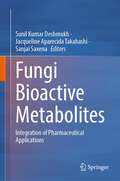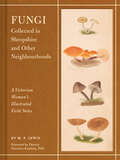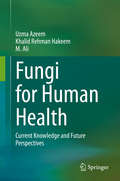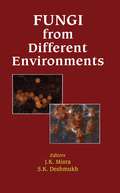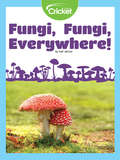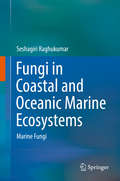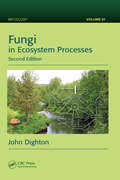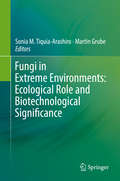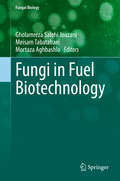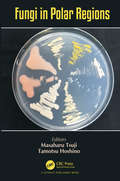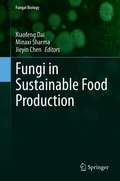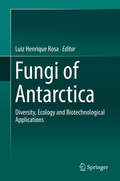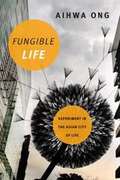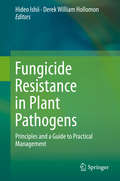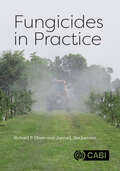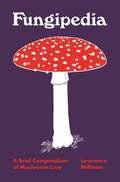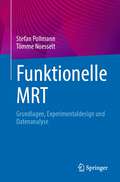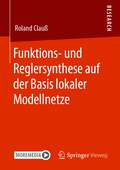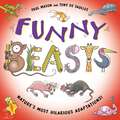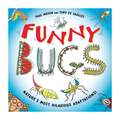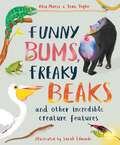- Table View
- List View
Fungi Bioactive Metabolites: Integration of Pharmaceutical Applications
by Sunil Kumar Deshmukh Jacqueline Aparecida Takahashi Sanjai SaxenaThis book presents the exploration and exploitation of various bioactive metabolites obtained from fungi isolated from diverse habitats for pharmaceutical applications. Various fungal sources have been brought under one umbrella ranging from endophytes, marine fungi, endolichenic fungi to fungi existing in the extremophilic conditions like desert and Antarctica and Artic environment. The book tries to cover maximally the range of the pharmaceutical applications wherein these bioactive agents from fungi have been exploited or are in the clinical pipelines and primarily include antibacterial, antifungal, antibiofilm, anticancer, antioxidant, autoimmunological, anti-inflammatory, and anti-thrombotic diseases. The book further emphasizes on the novel strategies to screen or enhance secondary metabolite production. Some other topics includes peptides, nonpeptides drugs, pigments, and enhancement of production of Echinocandin and Kojic acid. The role of bioinformatics in drug discovery and biotransformations have also been discussed. This book is going to be a comprehensive treatise and a valuable source for mycologists, biotechnologists, microbiologists, biotechnologists, and undertaking research in pharmaceutical sector as well as academia in setting up their research aspirations for using fungi in the process of drug discovery and development.
Fungi Collected in Shropshire and Other Neighbourhoods: A Victorian Woman's Illustrated Field Notes
by M. F. LewisVenture into the woods alongside a pioneering female mycologist. This one-of-a-kind, keepsake volume celebrates the timeless fascination of fungi.Very little is known about M. F. Lewis—not even her first name. Mysterious, prolific, and deeply enamored with the world of mushrooms, she left us a treasure trove of mycological illustrations. For over forty years, from 1860 to 1902, Lewis rambled across England and Wales, recording an astonishing biodiversity of fungi. Her delicately drawn, boldly colored images evoke the strange and powerful beauty of this kingdom. This handsome volume collects hundreds of Lewis's watercolors, contextualized by a foreword from mycologist Dr. Patricia Ononiwu Kaishian. It's a must-have for today's mushroom lovers who are curious about the history of mycology and for any admirer of vintage botanical illustration who wants to discover something different.FASCINATING FUNGI: Mushrooms are having a real moment, but they've always captured our imaginations, even in Victorian times. Lewis's gorgeous artwork offers the modern mushroom fan a new way to appreciate their favorite kingdom.VINTAGE AESTHETIC: This lovely clothbound volume evokes the magic of uncovering a treasure in a jumbled vintage bookstore. FEMINIST HISTORY: While little is known of the elusive M. F. Lewis, we can celebrate the legacy that she and other female naturalists of the 19th century left for women in science and art today.ARTFUL SCIENCE: Lewis's illustrated field notes showcase the intersection of art and science at its best.Perfect for:Mushroom hunters, eaters, and admirersFans of cottagecore and goblincore aestheticsCollectors of vintage books and vintage botanical illustrationCollectors of Victorian ephemeraReaders of feminist historyEnvironmentalists, scientists, and artists
Fungi for Human Health: Current Knowledge and Future Perspectives
by Uzma Azeem Khalid Rehman Hakeem M. AliCurrent research lays emphasis on exploring natural products for use in nutraceuticals and pharmaceuticals to overcome various side effects of synthetic drugs. Fungi occupy an eminent position among natural sources of food and medicinal importance since ancient times. Many fungal species have been eaten as food and used in folk medicine for the treatment of many human ailments as mentioned in traditional medical literature. However, scanty information is available pertaining to the nutraceutical and pharmaceutical importance of fungi which merits an extensive review. This book spotlights the use value macrofungi in human health. Macrofungi with health benefitting properties largely belong to Basidiomycota followed by Ascomycota growing indoor (cultivated) and outdoor (wild). We endeavoured to throw light on the benefits of macrofungal taxa in relation to their food and medicinal significance in human life. We provided knowledge pertaining to the ethnomycological significance of macrofungi with respect to their uses as food and medicine by the people inhabiting different parts of the world. This book highlights the nutritional composition and bioactive compounds present in macrofungi. We also focused on the pharmacological activities of macrofungi contributing towards their medicinal value against several human disorders. We cited many commercially available nutraceutical and pharmaceutical products of macrofungal origin. This work will hopefully serve as a basic reference for general public, mycologists, researches and industry men, interested in consumption, research and marketing of macrofungi.
Fungi from Different Environments
by J. K. MisraMycologists now look at the genes of fungi to decipher many features that they have been studying in the past beyond just looking at the morphology and other such traits of these organisms. Fungi are also attracting the attention of scientists in various other disciplines. These include the search for useful fungi in various extreme environments th
Fungi, Fungi, Everywhere!
by Gail JarrowWhat comes to mind with you think of fungi? Is it mushrooms, or perhaps mildew? Mold and yeast are fungi, too! Learn all about how fungi reproduce with spores, and how their bodies are made up of mycelium!
Fungi in Biogeochemical Cycles
by Geoffrey Michael GaddFungi play important roles in the cycling of elements in the biosphere but are frequently neglected within microbiological and geochemical research spheres. Symbiotic mycorrhizal fungi are responsible for major transformations and redistribution of inorganic nutrients, while free-living fungi have major roles in the decomposition of organic materials, including xenobiotics. Fungi are also major biodeterioration agents of stone, wood, plaster, cement and other building materials, and are important components of rock-inhabiting microbial communities. The aim of this 2006 book is to promote further understanding of the key roles that free-living and symbiotic fungi (in mycorrhizas and lichens) play in the biogeochemical cycling of elements, the chemical and biological mechanisms that are involved, and their environmental and biotechnological significance. Where appropriate, relationships with bacteria are also discussed to highlight the dynamic interactions that can exist between these major microbial groups and their integrated function in several kinds of habitat.
Fungi in Coastal and Oceanic Marine Ecosystems
by Seshagiri RaghukumarThis book offers an ecosystem-oriented overview of the diversity, ecological role, and biotechnological applications of marine fungi as well as an in-depth introduction to the marine environment, fungal classification, and ecological principles. It also presents the latest research findings on coastal marine and oceanic ecosystems, such as mangrove, seagrass, salt marsh, algal, coral reef and benthic ecosystems. Focusing on the diversity of fungi as well as their role as symbionts, parasites and saprotrophs, the book also discusses the physiology and biotechnological applications of fungi and highlights topics of future interest. Intended for students and researchers in marine biology and microbiology, it includes detailed descriptions, illustrations, figures, tables, and exhaustive literature citations. A detailed chapter on methods used to study marine fungi, their classification and ecological principles is of particular interest to newcomers in the field.
Fungi in Ecosystem Processes (Mycology #Vol. 17)
by John DightonThis new edition of Fungi in Ecosystem Processes continues the unique approach of examining the roles of fungi from the perspective of ecosystem functions. It explores how fungi have adapted to survive within particular constraints, how they help to maintain homeostasis in ecosystems, how they facilitate resistance to perturbations, and how they influence the communities of other organisms. Updated and revised, the second edition Expands the section on plant pathogens, invasive species, and insect–fungal interactions Provides more extensive coverage on insect–fungal interactions, including entomopathogens, the links between entomopathogens and endophytes, and symbiotic and mutualistic interactions Adds a new section on fungi in the built environment Presents new material on below-ground to above-ground interactions mediated through fungi, such as mycorrhizal signaling systems for herbivory defense The book also includes expanded coverage of the role of fungi in suppressive soils, aquatic and marine fungi, modern methods of following food chains in fungal–invertebrate trophic interactions, and the physiology of nutrient uptake by mycorrhizae. A necessary update and expansion to previous material, this book provides an essential reference on the current understanding of fungal roles in ecosystem processes. It also identifies directions for future study, including an emphasis on the need for further research on fungi in built environments.
Fungi in Extreme Environments: Ecological Role and Biotechnological Significance
by Sonia M. Tiquia–Arashiro Martin GrubeOver the last decades, scientists have been intrigued by the fascinating organisms that inhabit extreme environments. These organisms, known as extremophiles, thrive in habitats which for other terrestrial life-forms are intolerably hostile or even lethal. Based on such technological advances, the study of extremophiles has provided, over the last few years, ground-breaking discoveries that challenge the paradigms of modern biology. In the new bioeconomy, fungi in general, play a very important role in addressing major global challenges, being instrumental for improved resource efficiency, making renewable substitutes for products from fossil resources, upgrading waste streams to valuable food and feed ingredients, counteracting life-style diseases and antibiotic resistance through strengthening the gut biota, making crop plants more robust to survive climate change conditions, and functioning as host organisms for production of new biological drugs. This range of new uses of fungi all stand on the shoulders of the efforts of mycologists over generations. The book is organized in five parts: (I) Biodiversity, Ecology, Genetics and Physiology of Extremophilic Fungi, (II) Biosynthesis of Novel Biomolecules and Extremozymes (III) Bioenergy and Biofuel synthesis, and (IV) Wastewater and biosolids treatment, and (V) Bioremediation.
Fungi in Fuel Biotechnology (Fungal Biology)
by Gholamreza Salehi Jouzani Meisam Tabatabaei Mortaza AghbashloDue to the huge quantity and diverse nature of their metabolic pathways, fungi have great potential to be used for the production of different biofuels such as bioethanol, biobutanol, and biodiesel. This book presents recent advances, as well as challenges and promises, of fungal applications in biofuel production, subsequently discussing plant pathogenic fungi for bioethanol and biodiesel production, including their mechanisms of action. Additionally, this book reviews biofuel production using plant endophytic fungi, wood-rotting fungi, fungal biocontrol agents, and gut fungi, and it investigates highly efficient fungi for biofuel production and process design in fungal-based biofuel production systems. Finally, life cycle assessment of fungal-based biofuel production systems are discussed in this volume.
Fungi in Polar Regions
by Masaharu Tsuji Tamotsu HoshinoFungi that inhabit polar-region can grow and decompose organic compounds under subzero temperatures play important roles in the nutrient cycle of polar-region ecosystems. Thus, changes in the mycoflora affect the ecological recycling in these regions, and understanding the cold-adaptation strategies of fungi under extreme environments is critical for a better understanding of polar-region ecosystems. Due to their ability to survive under extreme environments, fungi in polar-region are seen to show potential for utilization in biotechnologies. This book presents our current understanding of the mycoflora in polar-region and their cold adaptation strategies, and applied studies using their abilities.
Fungi in Sustainable Food Production (Fungal Biology)
by Xiaofeng Dai Minaxi Sharma Jieyin ChenThis book presents research on the challenges and potential of fungal contribution in agriculture for food substantiality. Research on fungi plays an essential role in the improvement of biotechnologies which lead global sustainable food production. Use of fungal processes and products can bring increased sustainability through more efficient use of natural resources. Fungal inoculum, introduced into soil together with seed, can promote more robust plant growth through increasing plant uptake of nutrients and water, with plant robustness being of central importance in maintaining crop yields. Fungi are one of nature′s best candidates for the discovery of food ingredients, new drugs and antimicrobials. As fungi and their related biomolecules are increasingly characterized, they have turned into a subject of expanding significance. The metabolic versatility makes fungi interesting objects for a range of economically important food biotechnology and related applications. The potential of fungi for a more sustainable world must be realized to address global challenges of climate change, higher demands on natural resources.
Fungi of Antarctica: Diversity, Ecology and Biotechnological Applications
by Luiz Henrique RosaThis book focuses on the fungi found in one of the most pristine regions on Earth: Antarctica. It discusses the fungal occurrence in all substrates of the region, including soil, seawater, lake and marine sediments, rocks, ice, and snow. It also addresses the impact of climate changes on these organisms, the genomic techniques developed to study them, and how a number of compounds, such as antibiotics and enzymes, produced by the Antarctic fungi can be used in medicine, agriculture and the chemical industry.
Fungible Life: Experiment in the Asian City of Life
by Aihwa OngIn Fungible Life Aihwa Ong explores the dynamic world of cutting-edge bioscience research, offering critical insights into the complex ways Asian bioscientific worlds and cosmopolitan sciences are entangled in a tropical environment brimming with the threat of emergent diseases. At biomedical centers in Singapore and China scientists map genetic variants, disease risks, and biomarkers, mobilizing ethnicized "Asian" bodies and health data for genomic research. Their differentiation between Chinese, Indian, and Malay DNA makes fungible Singapore's ethnic-stratified databases that come to "represent" majority populations in Asia. By deploying genomic science as a public good, researchers reconfigure the relationships between objects, peoples, and spaces, thus rendering "Asia" itself as a shifting entity. In Ong's analysis, Asia emerges as a richly layered mode of entanglements, where the population's genetic pasts, anxieties and hopes, shared genetic weaknesses, and embattled genetic futures intersect. Furthermore, her illustration of the contrasting methods and goals of the Biopolis biomedical center in Singapore and BGI Genomics in China raises questions about the future direction of cosmopolitan science in Asia and beyond.
Fungicide Resistance in Plant Pathogens
by Hideo Ishii Derek William HollomonThis volume offers a comprehensive coverage of the general principles and recent advances in fungicide resistance. It describes the development, mechanisms, monitoring, and management of resistance and covers the most important group of fungicides that have caused resistance on various crops. An historical review of fungicide resistance over the past 40 years sets the scene for up-to-date basic information on mode of action, as well as the genetics, mechanisms, and evolution of resistance. Monitoring for resistance, including the latest developments in molecular diagnostics, moves readers into the practical aspects of resistance management, which is dealt with through a series of case studies outlining fungicide-use strategies on several key crops. The chapters reflect the experience of authors internationally recognised for their significant contributions to fungicide resistance research. The majority of crop diseases are caused by fungal pathogens, and disease control relies heavily on chemically synthesized fungicides. However, modern fungicides often encounter the problem of resistance development in target pathogens. Thus pathogen resistance to fungicides is an important factor that causes loss of yield and quality of crops. It often threatens biosecurity through the decrease of fungicide efficacy in the fields. To manage fungicide resistance successfully will require the promotion of integrated disease management, involving not just chemical fungicides, but also host plant resistance, agronomic factors, and reliable biological control agents where these are available. Well referenced throughout, the book offers a comprehensive account of resistance, which will be useful as a source of material for lecturers and for both industrial and academic scientists involved in fungicide resistance research. It is also a valuable sourcebook for students.
Fungicides in Practice
by Richard P. Oliver Professor Janna L BeckermanThis is an up-to-date guide on the science and practice of disease control based on fungicides in horticulture and broad acre agriculture. It describes how conventional, organic and biological fungicides are discovered, how they work and how resistance evolves. Chapters on formulation, mode of action, mobility and application inform decisions about which fungicides to use, when to use them, and how to rotate (or tank-mix) them, to manage both plant disease and fungicide resistance. A chapter on experimental design of fungicide trials aids practitioners in designing their own trials to evaluate how effective products are for their plant disease problem. Based on the successful 2014 book of Fungicides in Crop Protection this edition has four entirely new chapters, and extensive updates to the other nine chapters. The contents include: · Fungicide markets, discovery and performance. · Modes of action and spectrum. · Biological crop protection, and organic cultivation. · Fungicide formulation, mobility and application. · Experimental design of fungicide trials and their analysis. · Fungicide resistance. · Legislation and regulation. Written for crop protection professionals and scientists, growers, agronomists and consultants, the book is also suitable for students of agriculture and agronomy.
Fungipedia: A Brief Compendium of Mushroom Lore
by Fungipedia Lawrence MillmanAn illustrated mini-encyclopedia of fungal lore, from John Cage and Terrence McKenna to mushroom sex and fairy ringsFungipedia presents a delightful A–Z treasury of mushroom lore. With more than 180 entries—on topics as varied as Alice in Wonderland, chestnut blight, medicinal mushrooms, poisonings, Santa Claus, and waxy caps—this collection will transport both general readers and specialists into the remarkable universe of fungi.Combining ecological, ethnographic, historical, and contemporary knowledge, author and mycologist Lawrence Millman discusses how mushrooms are much more closely related to humans than to plants, how they engage in sex, how insects farm them, and how certain species happily dine on leftover radiation, cockroach antennae, and dung. He explores the lives of individuals like African American scientist George Washington Carver, who specialized in crop diseases caused by fungi; Beatrix Potter, creator of Peter Rabbit, who was prevented from becoming a professional mycologist because she was a woman; and Gordon Wasson, a J. P. Morgan vice-president who almost single-handedly introduced the world to magic mushrooms. Millman considers why fungi are among the most significant organisms on our planet and how they are currently being affected by destructive human behavior, including climate change.With charming drawings by artist and illustrator Amy Jean Porter, Fungipedia offers a treasure trove of scientific and cultural information. The world of mushrooms lies right at your door—be amazed!
Funktionelle MRT: Grundlagen, Experimentaldesign und Datenanalyse
by Stefan Pollmann Tömme NoesseltDie Funktionelle Magnetresonanztomographie (fMRT) hat sich als bahnbrechendes Instrument in den humanen Neurowissenschaften etabliert und wird in verschiedenen Disziplinen wie Medizin, Psychologie und Biologie sowohl für grundlagenwissenschaftliche als auch klinische Untersuchungen eingesetzt. "Einführung in die Funktionelle Magnetresonanztomographie" bietet eine verständliche Einführung in die Grundlagen der fMRT sowie eine ausführliche Erklärung der Designprinzipien von fMRT-Experimenten und der komplexen Schritte der Datenanalyse, einschließlich moderner multivariater Analyseverfahren.Dieses Buch ist sowohl für Einführungskurse auf Masterniveau als auch zum Selbststudium bei der Durchführung von fMRT-Projekten geeignet. Es führt den Leser durch alle notwendigen Schritte, angefangen von der Entwicklung eines Experiments bis hin zur Analyse und Präsentation der Daten sowie ihrer Interpretation. Dabei bringen die Autoren nicht nur ihre eigene Expertise als Mitentwickler der fMRT-Methodik ein, sondern veranschaulichen auch anhand eigener Untersuchungen die praktische Anwendung.Egal, ob Sie Einsteiger oder bereits erfahrener Forscher sind, dieses Buch wird Ihnen dabei helfen, Bildgebungsstudien besser zu verstehen und die fMRT zielgerichtet für Ihre neurowissenschaftliche Forschung zu nutzen.
Funktionelles Zusammenspiel von Gehirn und Herz: Von der Physiologie zur fortgeschrittenen Methodik der Signalverarbeitung und -modellierung
by Vincenzo Catrambone Gaetano ValenzaDiese Monographie bietet einen systemübergreifenden Austausch und eine modalitätsübergreifende Untersuchung des Zusammenspiels von Gehirn und Herz. Das Zusammenspiel von Gehirn und Herz (Brain-Heart Interplay, BHI) ist ein hochgradig interdisziplinäres wissenschaftliches Thema, das sich von der Physiologie des zentralen/autonomen Nervensystems, insbesondere des zentral-autonomen Netzwerks, bis hin zu fortgeschrittener Signalverarbeitung und Modellierung zur Quantifizierung seiner Aktivität erstreckt. Motiviert durch klinische Befunde und unterstützt durch die neuesten Erkenntnisse der Neurophysiologie, untersucht diese Monographie zunächst die Definition grundlegender Quantifizierer des Zusammenspiels von Gehirn und Herz und geht dann zu fortgeschrittenen Methoden für die Bewertung von Gesundheits- und Krankheitszuständen über. Der nicht-invasive Einsatz von Techniken zur Überwachung des Gehirns, einschließlich des Elektroenzephalogramms und der funktionellen Magnetresonanztomographie, wird zusammen mit der Überwachung der Herzschlagdynamik durch Pulsoximeter und EKG-Signale beschrieben.Das Buch richtet sich insbesondere an biomedizinische Ingenieure und Mediziner mit Fachkenntnissen in Statistik und/oder Signalverarbeitung. Aber auch Forscher in den Bereichen Kardiologie, Neurologie, Psychiatrie und Neurowissenschaften im Allgemeinen können sich für dieses Buch interessieren.
Funktions- und Reglersynthese auf der Basis lokaler Modellnetze
by Roland ClaußDer Autor untersucht eine Methode zur Realisierung modellbasierter Funktionsentwicklung im industriellen Umfeld und der damit einhergehenden zeitlichen Ristrektionen eines Entwicklungsprojekts. Der Schwerpunkt liegt dabei auf der Systemidentifikation (datenbasierten Modellbildung) statischer oder dynamischer nichtlinearer Systeme, die auf der Basis lokaler Modellnetze realisiert wird. Für die Strukturoptimierung der Modellnetze werden zwei neue Ansätze vorgestellt, die eine hohe Effizienz und Genauigkeit bei der Modellbildung aufweisen. Der Autor integriert im nächsten Schritt die identifizierten Modelle in verschiedene beschränkte prädiktive Mehrgrößenregler eines Wärmepumpensystems und zeigt eine Strategie auf, um das System im geschlossenen Regelkreis effizient auszulegen und zu validieren.
Funky Fungi: 30 Activities for Exploring Molds, Mushrooms, Lichens, and More (Young Naturalists #8)
by Alisha GabrielFungi are everywhere! They live in the coldest corner of Antarctica and on hot, sandy desert dunes. They're in the air you breathe and the food you eat. But fungi are more than pizza toppings. They form partnerships with plants and help us clean up our planet through bioremediation. Some fungi eat our crops; others protect them. Some fungi cause diseases; others cure them. Some are bigger than you; others are so tiny you need a microscope to see them. And now, people are finding ways to use fungi to make furniture, building materials, and even sneakers.So grab your gear and let's go find some Funky Fungi.
Funny Beasts: Laugh-out-loud nature facts! (Funny Nature #1)
by Paul MasonHeaps of funny facts and cartoons about the animal world's most hilarious adaptations!Animals have developed some downright strange features and behaviours to survive day in and day out. This book's lively artwork and side-splitting jokes bring these behaviours alive - and uncover the awesome science of the animal world. Meet the quirkiest, the flashiest, the stinkiest and of course the absolutely funniest animals on planet Earth!Funny Nature is a series of books presenting science learning through laughter. Brought to you by the author and illustrator of The Poo That Animals Do, this series covers science topics including evolution, adaptation, habitats, anatomy, physiology, life cycles and much more! Perfect for fans of facts and fun aged 6+.Books in the Funny Nature series:Funny BeastsFunny BugsFunny DinosaursFunny Plants
Funny Bugs: Laugh-out-loud nature facts! (Funny Nature #2)
by Paul MasonHeaps of funny facts and cartoons about the bug world's most hilarious adaptations!Bugs have developed some of the strangest features and behaviours to survive day in and day out. This book's lively artwork and side-splitting jokes bring these behaviours alive - and uncover the awesome science of the bug world. Meet the goofiest, the stinkiest, the best dancers and of course the absolutely funniest bugs on planet Earth!Funny Nature is a series of books presenting science learning through laughter. Brought to you by the author and illustrator of The Poo That Animals Do, this series covers science topics including evolution, adaptation, habitats, anatomy, physiology, life cycles and much more! Perfect for fans of facts and fun aged 6+.Books in the Funny Nature series:Funny BeastsFunny BugsFunny DinosaursFunny Plants
Funny Bums, Freaky Beaks: and Other Incredible Creature Features
by Alex Morss Sean Taylor'The child-appeal of Funny Bums, Freaky Beaks and Other Incredible Creature Features isn't limited to the title' - Guardian'A fascinating introduction to the diversity of life on earth ... This compendium intrigues and delights the reader. It celebrates evolution and creates a feeling of awe and wonder at the variety of the natural world. The book informs and inspires and can be dipped into again and again. Highly recommended for children aged 6+' - The English AssociationA delightful compendium of all the most unusual and unexpected features in the animal kingdom, from puzzling toes to weird ears, and all the other body parts in between! These creatures have strange features – but they all serve a very useful purpose! This charming and visually appealing book carries the underlying message that everybody and everything is strange and wonderful in its own way – difference should be celebrated!
Funny Butts, Freaky Beaks: and Other Incredible Creature Features
by Alex Morss Sean Taylor'The child-appeal of Funny Butts, Freaky Beaks and Other Incredible Creature Features isn't limited to the title' – GuardianA delightful compendium of all the most unusual and unexpected features in the animal kingdom, from puzzling toes to weird ears, and all the other body parts in between!These creatures have strange features – but they all serve a very useful purpose. This charming and visually appealing book carries the underlying message that everybody and everything is strange and wonderful in its own way – difference should be celebrated!'A fascinating introduction to the diversity of life on earth ... This compendium intrigues and delights the reader. It celebrates evolution and creates a feeling of awe and wonder at the variety of the natural world. The book informs and inspires and can be dipped into again and again. Highly recommended for children aged 6+' – The English Association
